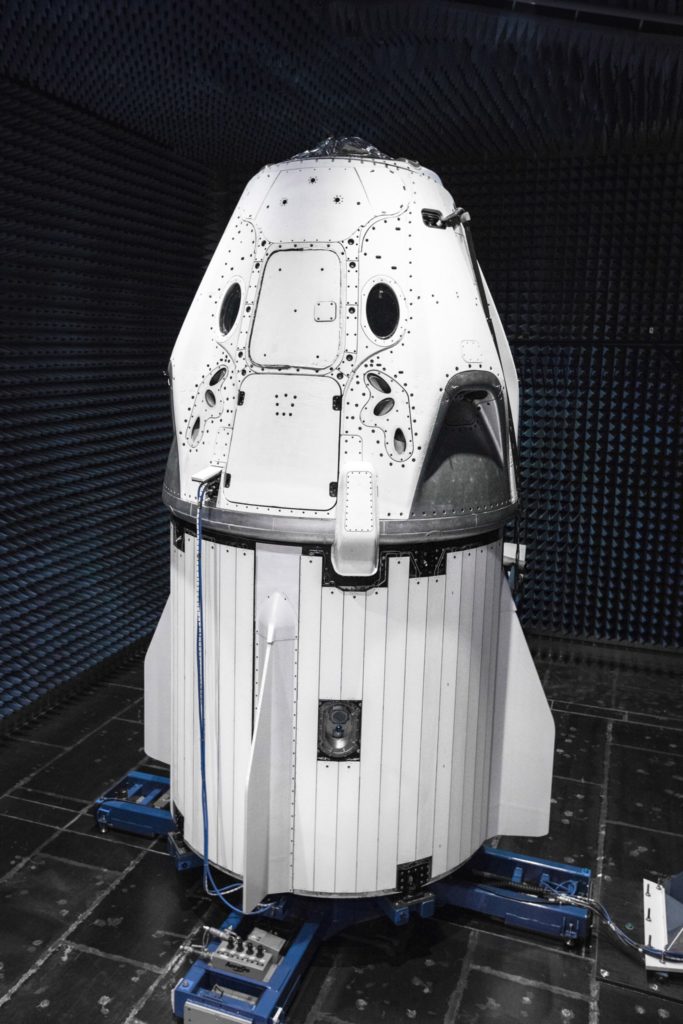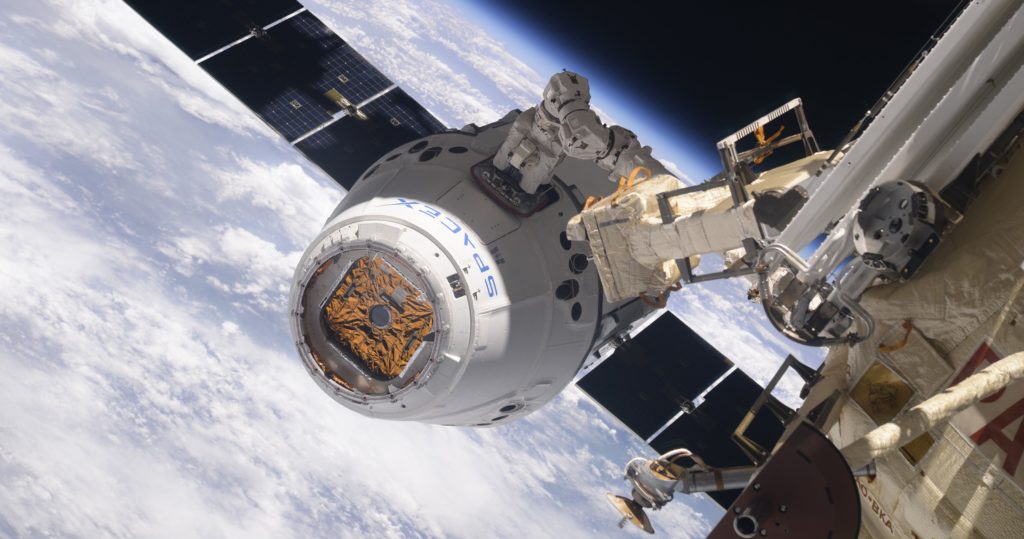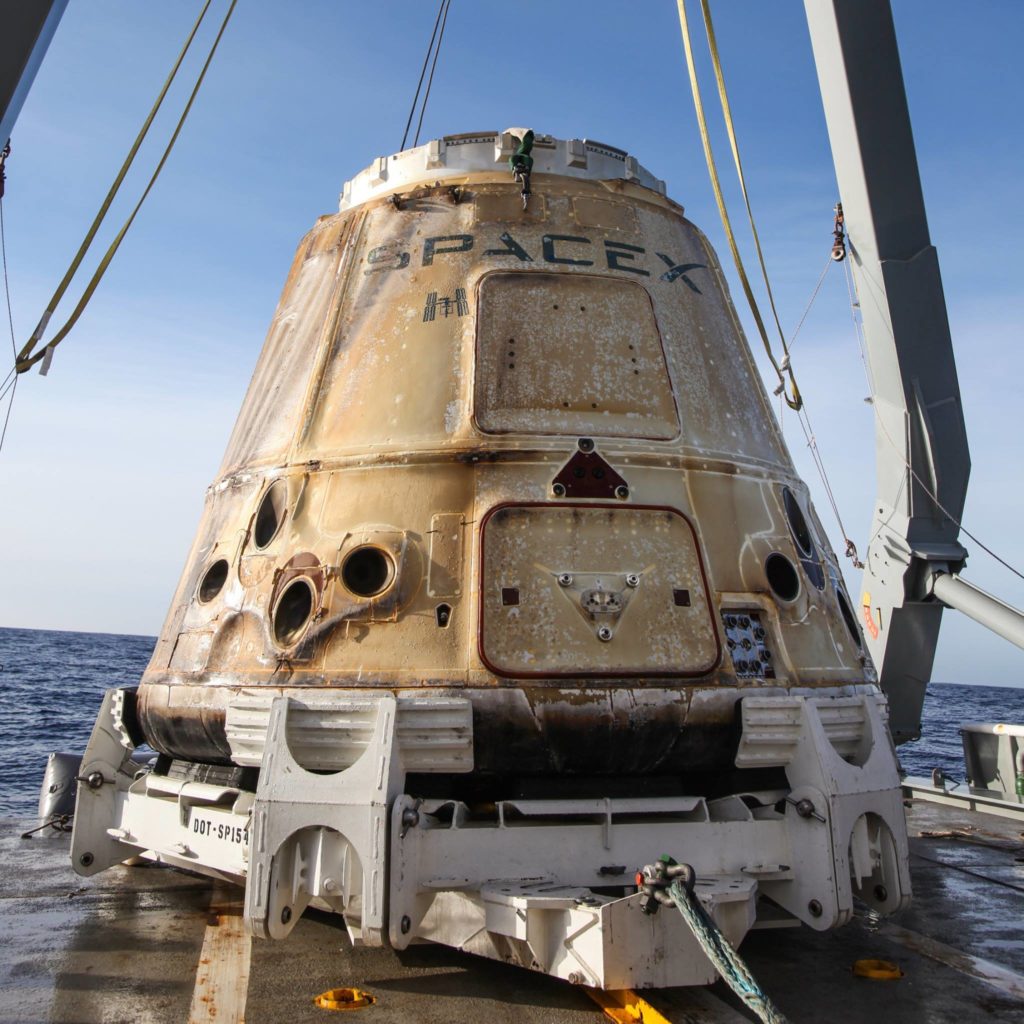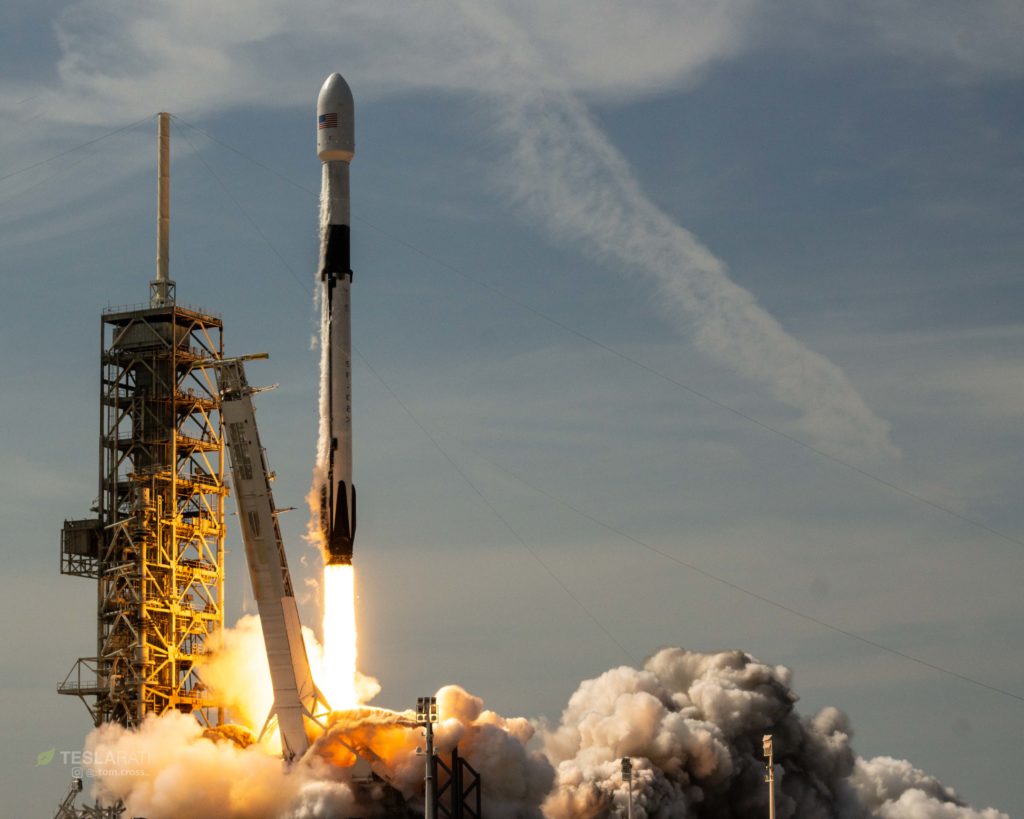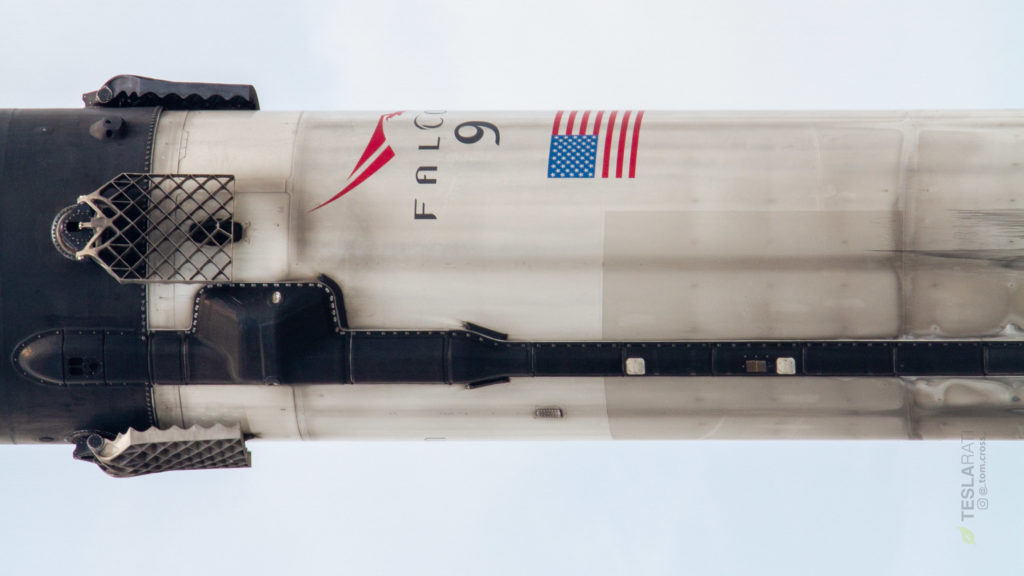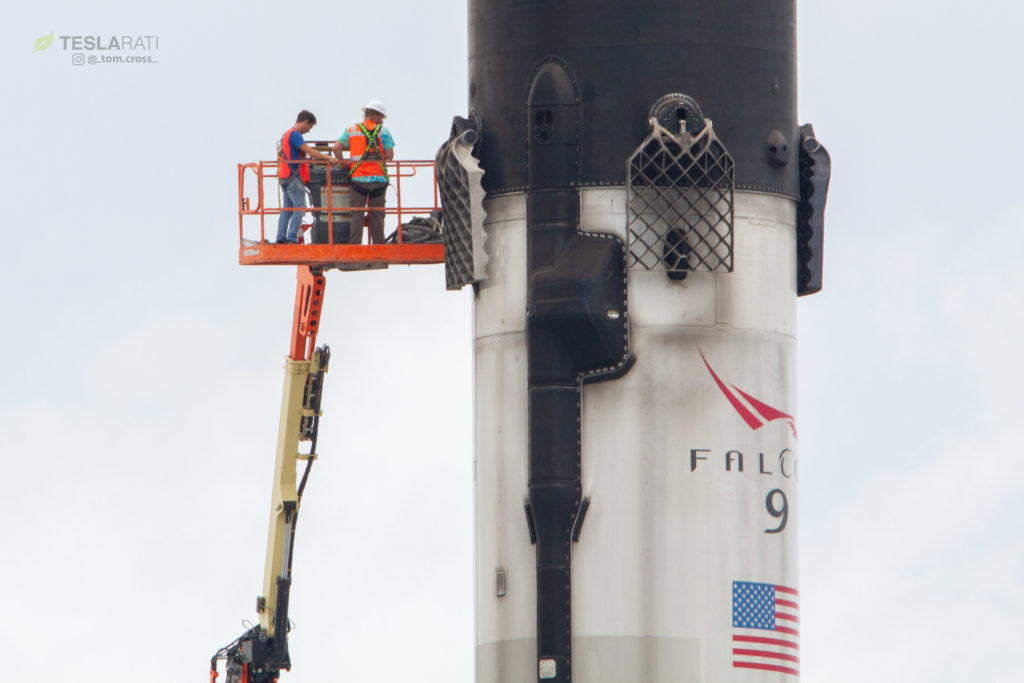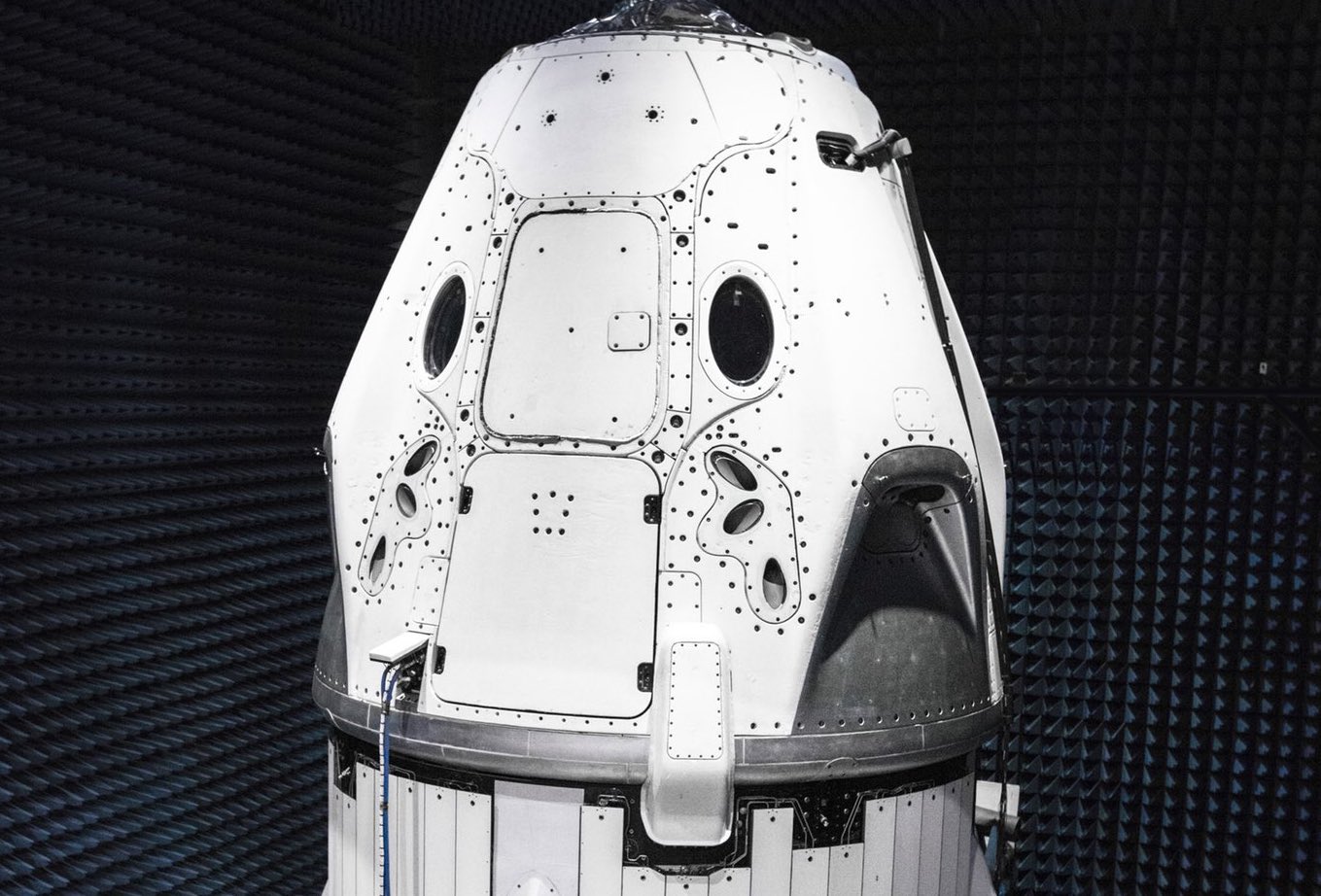
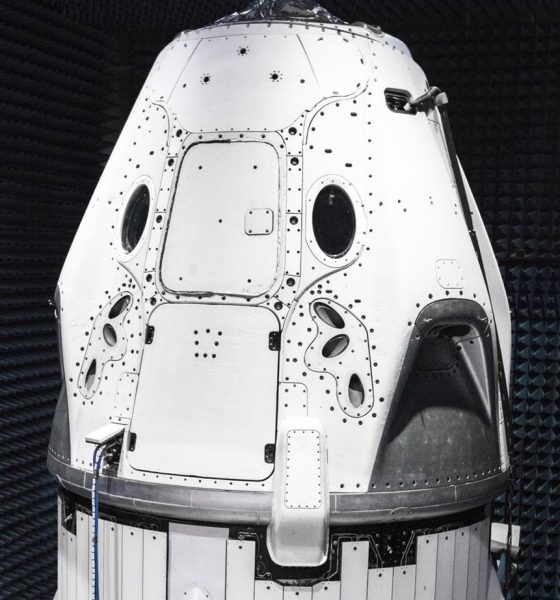
News
SpaceX’s Crew Dragon spaceship nears first orbital launch test
After roughly five years of concerted development, SpaceX CEO Elon Musk has released the first official photo of the company’s Crew Dragon, a version of their orbital spacecraft designed and optimized to reliably return humans to orbit from United States soil.
Traceable back to the very beginning of SpaceX’s first Dragon development program, where the company hoped to easily modify the Cargo Dragon capsule design to support crewed missions, the results of the years of work that followed instead focused on an extensive redesign originally intended to be capable of powered landings similar to Falcon 9 boosters. However, likely the result of an immense certification burden to ever hope to have NASA okay its operational usage, SpaceX chose to kill the landing program in favor of a more traditional ocean splashdown style of return. Extendable leglets were thus removed from the design’s heat shield, a change that also ended any hopes of SpaceX’s plans to partner with NASA and land an unprecedented payload on the surface of Mars, known as Red Dragon.
- Elon Musk: “SpaceX Crew Dragon ship in anechoic chamber for EMI [electromagentic interference] testing before being sent to @NASA Plum Brook vacuum chamber” (SpaceX)
- CRS-14’s flight-proven Cargo Dragon captured on orbit in April 2018 by astronaut Oleg Artemyev. (NASA/Oleg Artemyev)
- A reused orbital spacecraft, Cargo Dragon, back on Earth after its second successful resupply mission. (SpaceX)
That announcement came in the summer of 2017. Ten quiet months later, Musk confirmed April updates from NASA’s Commercial Crew Program managers with a photo of the first flight-worthy Crew Dragon in SpaceX’s anechoic chamber, ahead of shipment to NASA’s Plum Brook facility for full-up spacecraft testing in vacuum conditions.
While it may look like a completely different design, much of Crew Dragon has a significant level of heritage with the readily flight-proven Cargo Dragon spacecraft, including avionics, parachutes, heat shield expertise, and Draco maneuvering thrusters. The most obvious difference can be found in the four black bays spaced evenly around the edge of the capsule – these contain two SuperDraco thrusters each (eight total) that together act as an integrated launch abort system, capable of launching the capsule and trunk to safety in fractions of a second in the event of Falcon 9 failure at any point during launch. A test of this hardware was first completed almost exactly three years ago, demonstrating acceleration from stand-still to 100 mph in less than a single second.
The hardware shown in Elon Musk’s photo is not intended to carry humans (not on its first flight, at least), instead aiming to be the first Crew Dragon article to make it into Earth orbit, where SpaceX technicians and engineers will conduct and observe a vast fleet of tests with the intent of proving the craft’s capabilities. If successful, this mission (known as DM-1) will be the final step SpaceX needs to complete before DM-2, the upgraded spacecraft’s first real crewed mission.
As of now, DM-1 and DM-2 are officially scheduled for no earlier than (NET) August 31 and December 31 respectively. However, those dates are very unlikely to hold. Per sources with knowledge of Crew Dragon’s progress, DM-2 is currently scheduled for launch NET 2019, likely sometime in the first or second quarter. DM-1, while certainly not ready for an August 31 launch, does appear to be tracking towards a launch later this year, most likely in Q4 2018. SpaceX technicians are working around the clock to ready this groundbreaking hardware for its trip to Plum Brook and eventually to space, spending long shifts in the belly of the Dragon to ensure everything is working as intended.
- Falcon 9 Block 5 completed its first launch on May 11, carrying the Bangabandhu-1 communications satellite to geostationary transfer orbit. (Tom Cross)
- SpaceX’s first successfully launched and landed Block 5 Falcon 9, May 2018. (Tom Cross)
- B1046 returned to Port Canaveral shortly after its May 4 debut, and is now being carefully analyzed as pathfinder hardware. (Tom Cross)
Falcon 9 Block 5, which successfully completed its inaugural launch earlier this month, is another critical path for SpaceX’s first crewed mission (DM-2). As of now, NASA’s Aerospace Safety Advisory Panel (ASAP) has advised NASA to require seven full-up successful launches of the Block 5 iteration before allowing crew to fly on the rocket. In order for SpaceX to achieve that milestone in time for a crewed launch in early 2019, Falcon 9 Block 5 will need to fly (and refly) flawlessly over the course of the second half of 2018. While unclear if ASAP will accept flight-proven launches of the upgraded rocket for its fairly arbitrary “seven launches” requirement, SpaceX will need to rely heavily on Block 5 reflights if they hope to complete as many as 30 launches total this year.
As of now, the next launch of Falcon 9 Block 5 is likely to occur sometime in June, with three total Block 5 flights tentatively scheduled before mid-July. If SpaceX can pull those launches off, it will act as a huge bode of confidence for the future of the rocket, as well as the future of Crew Dragon.
Follow us for live updates, behind-the-scenes sneak peeks, and a sea of beautiful photos from our East and West coast photographers.
Teslarati – Instagram – Twitter
Tom Cross – Twitter
Pauline Acalin – Twitter
Eric Ralph – Twitter

News
Tesla FSD fleet is nearing 7 billion total miles, including 2.5 billion city miles
As can be seen on Tesla’s official FSD webpage, vehicles equipped with the system have now navigated over 6.99 billion miles.

Tesla’s Full Self-Driving (Supervised) fleet is closing in on almost 7 billion total miles driven, as per data posted by the company on its official FSD webpage.
These figures hint at the massive scale of data fueling Tesla’s rapid FSD improvements, which have been quite notable as of late.
FSD mileage milestones
As can be seen on Tesla’s official FSD webpage, vehicles equipped with the system have now navigated over 6.99 billion miles. Tesla owner and avid FSD tester Whole Mars Catalog also shared a screenshot indicating that from the nearly 7 billion miles traveled by the FSD fleet, more than 2.5 billion miles were driven inside cities.
City miles are particularly valuable for complex urban scenarios like unprotected turns, pedestrian interactions, and traffic lights. This is also the difference-maker for FSD, as only complex solutions, such as Waymo’s self-driving taxis, operate similarly on inner-city streets. And even then, incidents such as the San Francisco blackouts have proven challenging for sensor-rich vehicles like Waymos.
Tesla’s data edge
Tesla has a number of advantages in the autonomous vehicle sector, one of which is the size of its fleet and the number of vehicles training FSD on real-world roads. Tesla’s nearly 7 billion FSD miles then allow the company to roll out updates that make its vehicles behave like they are being driven by experienced drivers, even if they are operating on their own.
So notable are Tesla’s improvements to FSD that NVIDIA Director of Robotics Jim Fan, after experiencing FSD v14, noted that the system is the first AI that passes what he described as a “Physical Turing Test.”
“Despite knowing exactly how robot learning works, I still find it magical watching the steering wheel turn by itself. First it feels surreal, next it becomes routine. Then, like the smartphone, taking it away actively hurts. This is how humanity gets rewired and glued to god-like technologies,” Fan wrote in a post on X.
News
Tesla starts showing how FSD will change lives in Europe
Local officials tested the system on narrow country roads and were impressed by FSD’s smooth, human-like driving, with some calling the service a game-changer for everyday life in areas that are far from urban centers.

Tesla has launched Europe’s first public shuttle service using Full Self-Driving (Supervised) in the rural Eifelkreis Bitburg-Prüm region of Germany, demonstrating how the technology can restore independence and mobility for people who struggle with limited transport options.
Local officials tested the system on narrow country roads and were impressed by FSD’s smooth, human-like driving, with some calling the service a game-changer for everyday life in areas that are far from urban centers.
Officials see real impact on rural residents
Arzfeld Mayor Johannes Kuhl and District Administrator Andreas Kruppert personally tested the Tesla shuttle service. This allowed them to see just how well FSD navigated winding lanes and rural roads confidently. Kruppert said, “Autonomous driving sounds like science fiction to many, but we simply see here that it works totally well in rural regions too.” Kuhl, for his part, also noted that FSD “feels like a very experienced driver.”
The pilot complements the area’s “Citizen Bus” program, which provides on-demand rides for elderly residents who can no longer drive themselves. Tesla Europe shared a video of a demonstration of the service, highlighting how FSD gives people their freedom back, even in places where public transport is not as prevalent.
What the Ministry for Economic Affairs and Transport says
Rhineland-Palatinate’s Minister Daniela Schmitt supported the project, praising the collaboration that made this “first of its kind in Europe” possible. As per the ministry, the rural rollout for the service shows FSD’s potential beyond major cities, and it delivers tangible benefits like grocery runs, doctor visits, and social connections for isolated residents.
“Reliable and flexible mobility is especially vital in rural areas. With the launch of a shuttle service using self-driving vehicles (FSD supervised) by Tesla in the Eifelkreis Bitburg-Prüm, an innovative pilot project is now getting underway that complements local community bus services. It is the first project of its kind in Europe.
“The result is a real gain for rural mobility: greater accessibility, more flexibility and tangible benefits for everyday life. A strong signal for innovation, cooperation and future-oriented mobility beyond urban centers,” the ministry wrote in a LinkedIn post.
News
Tesla China quietly posts Robotaxi-related job listing
Tesla China is currently seeking a Low Voltage Electrical Engineer to work on circuit board design for the company’s autonomous vehicles.

Tesla has posted a new job listing in Shanghai explicitly tied to its Robotaxi program, fueling speculation that the company is preparing to launch its dedicated autonomous ride-hailing service in China.
As noted in the listing, Tesla China is currently seeking a Low Voltage Electrical Engineer to work on circuit board design for the company’s autonomous vehicles.
Robotaxi-specific role
The listing, which was shared on social media platform X by industry watcher @tslaming, suggested that Tesla China is looking to fill the role urgently. The job listing itself specifically mentions that the person hired for the role will be working on the Low Voltage Hardware team, which would design the circuit boards that would serve as the nervous system of the Robotaxi.
Key tasks for the role, as indicated in the job listing, include collaboration with PCB layout, firmware, mechanical, program management, and validation teams, among other responsibilities. The role is based in Shanghai.
China Robotaxi launch
China represents a massive potential market for robotaxis, with its dense urban centers and supportive policies in select cities. Tesla has limited permission to roll out FSD in the country, though despite this, its vehicles have been hailed as among the best in the market when it comes to autonomous features. So far, at least, it appears that China supports Tesla’s FSD and Robotaxi rollout.
This was hinted at in November, when Tesla brought the Cybercab to the 8th China International Import Expo (CIIE) in Shanghai, marking the first time that the autonomous two-seater was brought to the Asia-Pacific region. The vehicle, despite not having a release date in China, received a significant amount of interest among the event’s attendees.
